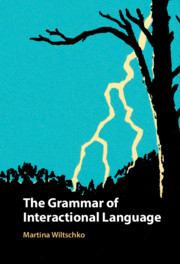Book contents
- The Grammar of Interactional Language
- The Grammar of Interactional Language
- Copyright page
- Dedication
- Contents
- Figures
- Tables
- Conversation Boards
- Acknowledgments
- Abbreviations
- Prologue
- 1 Interactional Language
- 2 The Syntacticization of Speech Acts
- 3 From Speech Acts to Interaction
- 4 The Interactional Spine Hypothesis
- 5 Initiating Moves: A Case-Study of Confirmationals
- 6 Reacting Moves: A Case-Study of Response Markers
- 7 The Grammar of Interactional Language
- Epilogue
- Bibliography
- Index
5 - Initiating Moves: A Case-Study of Confirmationals
Published online by Cambridge University Press: 28 May 2021
- The Grammar of Interactional Language
- The Grammar of Interactional Language
- Copyright page
- Dedication
- Contents
- Figures
- Tables
- Conversation Boards
- Acknowledgments
- Abbreviations
- Prologue
- 1 Interactional Language
- 2 The Syntacticization of Speech Acts
- 3 From Speech Acts to Interaction
- 4 The Interactional Spine Hypothesis
- 5 Initiating Moves: A Case-Study of Confirmationals
- 6 Reacting Moves: A Case-Study of Response Markers
- 7 The Grammar of Interactional Language
- Epilogue
- Bibliography
- Index
Summary
Chapter 5 presents a case-study of confirmationals and introduces a syntactic analysis within the framework of the Interactional Spine Hypothesis. Confirmationals are units of language which express a request for confirmation. I show that the target of confirmation can differ depending on the syntactic context. This is an instance of multi-functionality, which is best analyzed as being syntactically conditioned. As such the pattern of confirmationals within and across languages provides evidence for the interactional spine; it is the system which regulates the function and distribution of confirmationals. I discuss in detail the kind of variation we observe. That is, within and across languages, confirmationals differ as to who hasauthority over the knowledge to be confirmed, to what degree the belief to be confirmed holds, and when this belief came into existence. Moreover, we also observe that in some languages confirmationals come in full paradigms (e.g., Mandarin Chinese) whereas in others the inventory of confirmationals is much more restricted (English). I further show how confirmationals can be combined with intonational tunes to derive the complex meaning that they may have. Finally, I discuss other units of language that share some properties with confirmationals, such as evidentials.
Keywords
- Type
- Chapter
- Information
- The Grammar of Interactional Language , pp. 93 - 146Publisher: Cambridge University PressPrint publication year: 2021

